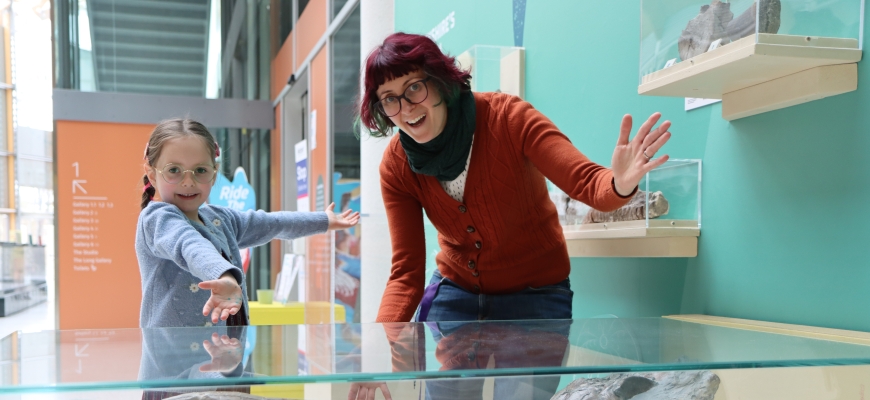
Following months of deliberations, suggestions and votes, the Herbert Art Gallery can announce its star ichthyosaur skull finally has a name.
After a naming competition was announced earlier in the year, over a hundred suggestions were whittled down to five by a carefully selected panel of judges consisting of hugely respected palaeontologists. These five were then put to the public vote.
We can now confirm the public have decided to name the specimen Finn.
The person who suggested the winning name is six-year-old Annabelle Elvis, who won with 59 per cent of the vote and wins a special dino-themed goody bag.
Annabelle said: “I thought of the name Finn because the ichthyosaur has a fin it uses to swim! It’s also a bit like a dolphin, and I have a friend called Finn!”
Annabelle’s mum Ruth Elvis said: “We told her this morning when she was in bed waking up! She was so happy to hear she had won!”
“I was really, really excited!” said Annabelle.
Annabelle’s grandma Rosemary Elvis said: “I am just so proud! Last time they came to The Herbert, all she wanted to tell me was that she had entered this naming competition with her suggestion, and it’s amazing that she’s now won! A real fairy tale story.”
The ichthyosaur display will be updated to feature a plaque containing its new name alongside Annabelle’s.
Ali Wells, curator at the Herbert, said: “We had loads of great suggestions for the ichthyosaur’s name, including naming it after our founded Sir Alfred Herbert. However, I’m really happy with the name the public have voted for.
“The judges, Emma Bernard from the Natural History Museum and Jon Radley from Museums Warwickshire, liked Finn because it evokes the anatomy of the ancient marine reptile. Many of the species had a dorsal fin on top of their body.
“Our ichthyosaur is one of our prized items, one we’re incredibly proud to be able to display. So I’m really pleased it now has its own name which I think will help visitors, in particular younger ones, to really relate to the specimen, and then incidentally with our local natural history. This feels particularly pertinent with the current challenges the planet is facing.”
This specimen, along with tens of others, was found at Harbury Cement Quarry. A well-known Coventry naturalist and member of the Coventry and District Natural History and Scientific Society, EF Nicholls, arranged for the skull to be moved from the quarry to Coventry for display.
This heavy specimen was transported from Harbury by his son, who, tiring of the weight on the saddle of his bike, offloaded his cargo in a ditch at Princethorpe. On returning home he was severely reprimanded by his father and made to return to the ditch the next morning and complete the fossil's journey to Coventry, where it was placed in the Field Club room at Upper York Street.
The Nicholls’s fossil collection was given to the Herbert in 1961, the year after the museum opened. This specimen was a key part of its natural science displays from 2008 to 2020 and is now the central piece in its Warwickshire Jurassic Sea display alongside Dippy in the Covered Court.
Ichthyosaur facts:
Ichthyosaurs are not dinosaurs, but their sea-based cousins, also known as marine reptiles. They lived in the sea and came to the surface for air.
Ichthyosaurs are extinct and looked similar to modern dolphins, although they are not related. They hunted sea creatures such as ammonites and fish.
Ichthyosaurs had large eye sockets and special bones, called a sclerotic ring, which helped to protect the eye from water pressure at depth. Different species ranged from one to 20 metres long.
Local facts:
The Jurassic Period began about 200 million years ago and lasted for around 55 million years. Dippy, currently on loan from the Natural History Museum, residing in Herbert’s covered court, lived towards the end of the Jurassic, about 150 million years ago.
At the beginning of the Jurassic, Britain was further south than it is now. Much of England and Wales were covered in warm shallow seas, including Warwickshire. These seas were filled with marine life, such as shellfish, reptiles and squid and snail-like creatures from the cephalopod family.
Several complete ichthyosaur skeletons have been found in Warwickshire.
Pictured: Annabelle accompanied by Herbert Art Gallery curator Ali Wells
